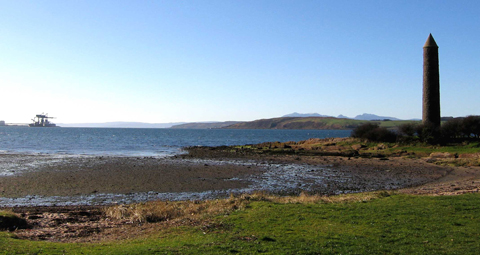July 14 | ![]() 0 COMMENTS
0 COMMENTS ![]() print
print

Finding Vikings, ice cream and God
In the second of the series, ROSS AHLFELD heads to th Ayrshire town of Largs -By ROSS AHLFELD
Tomorrow with Paul and Sverr my brothers, I sail for Scotland. A thousand sea-borne swords, a golden mask. Bjorn the Shetlander Sails to Largs, 1263.
By George Mackay Brown.
Many among the faithful regard Gerard Manley Hopkins as the finest ever Catholic poet, while for some this honour must go to the great Alighieri, and other still prefer Prudentius—but for me, the foremost Catholic poet has to be our own George Mackay Brown.
In the verse above, Mr Mackay Brown refers to a young Viking sailing to the battle of Largs, making the journey across what the writer Robert MacFarlane describes in his book The Old Ways, as the ‘verger’ in Norse and the ‘rathad mara’ in Gaelic, in English the sea lanes or ocean roads.
The ‘golden mask’ alluded to here is a reference to the young warrior’s ability to grow a fine golden beard, indicating that he has finally come of age for war.
More than 750 years after the battle of Largs, people still come to this part of Ayrshire, fortunately no longer to engage in bloody combat.
Unless you count the Auchinleck boys who used to come to Largs for the Friday night indie disco at Fiddler’s nightclub back in the 90s, where I used to go to with Jane, my then girlfriend, now wife.
I’m not saying these Auchinleck lads were rough but there is an old joke in Ayrshire which says Kilbirnie is famous for steel, Cumnock is famous for coal and Auchinleck is famous for stealin’ coal (versions of this gag vary depending on who is telling it and from which town or village they come).
Ayrshire banter aside, these days folk come to this traditional old seaside town to enjoy a game of pitch and putt followed by an ice cream surrounded by Art Deco splendour in the famous Nardini cafe. Other Flâneur types prefer a casual saunter along the prom, which Hugh MacDonald describes in his guide from 1857 Days at the Coast, as a ‘spacious esplanade, where visitors may recreate themselves, which is alive with walkers, young, old and middle aged, who for the most part are apparently strangers, determined to make the most of their money and their time by inhaling the largest possible draughts of the ‘caller air,’ and by ‘douking’ at every available opportunity.’
For me however, there are only two reasons to come to Largs. One is to watch the mighty Largs Thistle FC Juniors play at Barrfields Park. My brother had a spell at ‘The Theesel’ as a coach and assistant manager while my Dad used to often come here to scout players for Partick Thistle back in the days when semi-professional players still progressed to professional clubs.
These days, we all remain very fond of the club and we still like to travel down and watch them play whenever we can.
The second but single most important reason to come here is to be with the Christ who dwells among the Tyburn Nuns at Largs Benedictine Monastery.
The Tyburn Nuns are properly known as the Benedictine Adorers of the Sacred Heart of Jesus of Montmartre and their life is centred on Eucharistic Adoration for the glory of God and prayer for the needs of the whole human family.
Like the Canons of the Institute of Christ the King Sovereign Priest at St Walburge’s in Preston, the Tyburn Nuns have their spiritual roots in France, hold a special devotion to the Eucharist and the Sacred Heart of Jesus and are committed to upholding the oldesttraditions of our Church.
More so, the rule of St Benedict gives an instruction which asks that ‘all guests who present themselves are to be welcomed as Christ’ and that ‘proper honour must be shown to all.’
This is precisely what you’ll find when you visit the hospitable and kindly mother prioress and the Sisters at the Benedictine Monastery at Largs, which has a beautiful little shrine chapel and sanctuary where the nuns celebrate the Liturgy of the Hours and Adoration of the Blessed Sacrament.
As well as this, they have a cosy wee tearoom and there is also a very fine museum within the building, which is full of magnificent old vestments and precious liturgical objects.
The sisters also keep a lovely little guest house for pilgrims and visitors as well as organising study days on topics such as the spirituality and the teachings of the Foundress, Servant of God Mother Marie-Adele Garnier.
Most importantly, the sisters invite us all to join them in going to meet Jesus through contemplation and prayerful adoration of the Blessed Sacrament with deep reverence.
Throughout every day and night, all the Sisters share time of prayer before the monstrance, ensuring a continuous cycle of worship of God, and it is this sacrifice which lies at the heart of their vocation and dedication. The Sisters also maintain daily participation in the Holy Mass alongside the choral celebration of the Divine Office.
Perhaps you’re wondering what the sisters perpetual devotion to the Blessed Sacrament has to do with all the folks enjoying this busy wee seaside resort, oblivious to the daily rhythm of monastic life going on inside this monastery that sits right on the seafront.
Yet the work taking place within the monastery is offered for all the Glasgow Fair daytrippers strolling along the prom enjoying an ice cream.
It is also for all the fans at the football on a Saturday afternoon and even the lads from Auchinleck on a Friday night.
Yes, the sisters live a cloistered life, but it is a cloistered life and a self-abandonment lived in the service of us all, offering prayers of intercession for you and me, the entire country and the whole world.
Mother Marie Adele Garnier is especially famed for favours which specifically relate to the daily struggles of ordinary people like us. People often ask the foundress to pray for them with regards to matters concerning babies, families, work, employment property, financial matters, and any spiritual needs.
In my opinion, Mother Marie Adele’s journey to canonisation will eventually be confirmed through such intercessions.
To conclude this wee pilgrimage, I called into the local parish church very near the monastery, St Mary’s Star of the Sea, to give thanks and then I enjoyed a fish supper on the esplanade before heading home.
As I sat and gazed across the broad majestic Firth of Clyde out beyond the Isle of Cumbrae towards Bute and Kintyre, the sun began to settle down and I thought on the words of Gerard Manley Hopkins: “The world is charged with the grandeur of God.”
And I thought, too, on another verse from a George Mackay Brown poem:
Guard the ploughs and the nets.
Star of the sea, shine for us.
Our Lady of the Waves.










